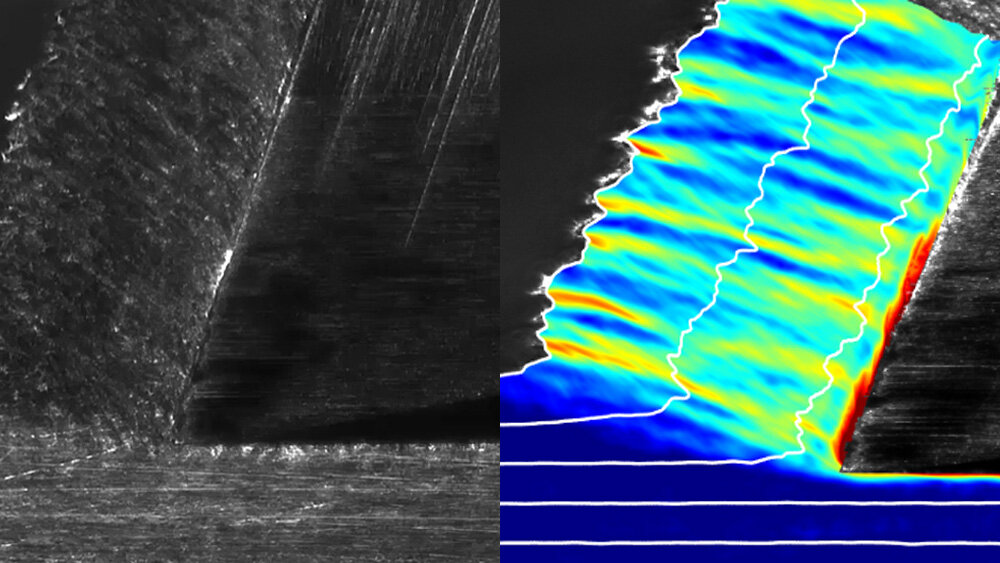
Researchers at Texas A&M University are taking a novel approach to understand the behavior of metals under extreme conditions. They are utilizing the metal cutting process, a traditional manufacturing tool, to develop a more accessible method for studying material properties.
Metal cutting, which involves scraping a thin layer of material from a metal’s surface using a sharp knife, is not typically associated with material property studies. However, Drs. Dinakar Sagapuram and Hrayer Aprahamian from the Wm Michael Barnes ’64 Department of Industrial and Systems Engineering at Texas A&M University saw its potential in predicting material behavior under various deformation conditions. Their research team includes Harshit Chawla, a doctoral student in industrial and systems engineering, and Dr. Shwetabh Yadav, an assistant professor at the Indian Institute of Technology Hyderabad.
“Understanding how materials deform and fail under harsh mechanical conditions is crucial for various technological applications, such as manufacturing processes, crash testing of vehicles, and impact testing for defense-related applications,” explained Chawla.
By locally shearing or deforming the metal to extreme levels under high rates, the team hypothesized that the metal cutting process could provide fundamental information on the material’s strength and resistance to plastic deformation or irreversible shape change. Moreover, metal cutting offers advantages over conventional testing methods, as it can produce a range of conditions that are challenging to achieve otherwise.
“The research opens new possibilities for metal cutting as a ‘property test’, allowing material scientists and physicists to validate their theories,” stated Sagapuram. “With numerous mathematical theories of metal plasticity under high strain rates, the property information obtained through metal cutting can help identify which theories are valid.”
The team employs a high-speed camera to observe how metals deform and shear when they encounter a sharp cutting tool. They then use this visual data to deduce the basic property information of the metals. Despite metal cutting not being Aprahamian’s area of expertise, his collaboration with Sagapuram has generated new ideas and numerical techniques.
“A crucial aspect of our research is to establish mathematical optimization techniques that guarantee global optimality, thereby achieving the most accurate results,” Aprahamian emphasized. “This is essential to accurately describe the material properties and prevent obtaining solutions that seem satisfactory but are misleading.”
“Metal cutting as a method to determine material properties offers simplicity and accessibility that are lacking in current testing methods,” expressed Sagapuram. “Practically anyone with access to a machine shop can now obtain material data without requiring sophisticated testing capabilities.”
The team’s work has been published in the Proceedings of the Royal Society A journal, with additional papers on numerical techniques currently in progress. The research is supported by a grant from the National Science Foundation. Furthermore, the team has initiated collaborations with the Los Alamos National Laboratory to cross-compare their data with established material dynamic strength testing platforms available on-site.
Aprahamian mentioned that their mathematical techniques have potential applications beyond material characterization. “We are extending some of these algorithms and techniques to the healthcare field, where we are utilizing global optimization tools to develop robust screening strategies. This can be used to prevent future outbreaks and improve screening for infectious diseases among the population,” he revealed.
Chawla expressed excitement about working in a field that has interested him for many years. “It was fascinating to study the mechanics of the metal cutting process using innovative experimental techniques. Observing the material deformation during cutting, especially at a microscopic level and high frame rates, was truly captivating,” he said.
More information: Determining large-strain metal plasticity parameters using in-situ measurements of plastic flow past a wedge, Proceedings of the Royal Society A: Mathematical and Physical Sciences (2023). DOI: 10.1098/rspa.2023.0061. royalsocietypublishing.org/doi … .1098/rspa.2023.0061
Citation: Staying sharp: Researchers turn to an everyday shop tool to study how materials behave (2023, July 19) retrieved 19 July 2023 from https://phys.org/news/2023-07-staying-sharp-everyday-tool-materials.html
This document is subject to copyright. Apart from any fair dealing for the purpose of private study or research, no part may be reproduced without the written permission. The content is provided for information purposes only.
Denial of responsibility! SamacharCentrl is an automatic aggregator of Global media. In each content, the hyperlink to the primary source is specified. All trademarks belong to their rightful owners, and all materials to their authors. For any complaint, please reach us at – [email protected]. We will take necessary action within 24 hours.

Shambhu Kumar is a science communicator, making complex scientific topics accessible to all. His articles explore breakthroughs in various scientific disciplines, from space exploration to cutting-edge research.

